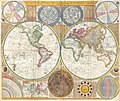File:1794 Samuel Dunn Wall Map of the World in Hemispheres - Geographicus - World2-dunn-1794.jpg

Size of this preview: 712 × 600 pixels. Other resolutions: 285 × 240 pixels | 570 × 480 pixels | 912 × 768 pixels | 1,216 × 1,024 pixels | 2,431 × 2,048 pixels | 6,000 × 5,054 pixels.
Original file (6,000 × 5,054 pixels, file size: 8.92 MB, MIME type: image/jpeg)
File history
Click on a date/time to view the file as it appeared at that time.
| Date/Time | Thumbnail | Dimensions | User | Comment | |
|---|---|---|---|---|---|
| current | 20:01, 1 June 2012 |  | 6,000 × 5,054 (8.92 MB) | Brandmeister~commonswiki | Reverted to version as of 04:17, 23 March 2011 |
| 16:15, 19 May 2012 |  | 6,000 × 5,054 (27.38 MB) | Brandmeister~commonswiki | contrast | |
| 04:17, 23 March 2011 |  | 6,000 × 5,054 (8.92 MB) | BotMultichillT | {{subst:User:Multichill/Geographicus |link=http://www.geographicus.com/P/AntiqueMap/World2-dunn-1794 |product_name=1794 Samuel Dunn Wall Map of the World in Hemispheres |map_title=A General Map of the World, or Terraqueouis Globe with all the New Discover |
File usage
The following pages on the English Wikipedia use this file (pages on other projects are not listed):
- A General Map of the World, or Terraqueous Globe
- Early world maps
- History of cartography
- Samuel Dunn (mathematician)
- Southern Ocean
- User:Cruickshanks/sandbox2
- User:Jacobwilder427
- User:Sarangem
- User:Setvina/be bold
- Wikipedia:Featured picture candidates/1794 Samuel Dunn Map
- Wikipedia:Featured picture candidates/1794 Samuel Dunn Wall Map of the World in Hemispheres - Geographicus - World2-dunn-1794.jpg (review)
- Wikipedia:Featured picture candidates/June-2012
- Wikipedia:Featured picture candidates/March-2014
- Portal:Maps
Global file usage
The following other wikis use this file:
- Usage on alt.wikipedia.org
- Usage on ar.wikipedia.org
- Usage on av.wikipedia.org
- Usage on br.wiktionary.org
- Usage on ckb.wikipedia.org
- Usage on cv.wikipedia.org
- Usage on de.wikipedia.org
- Usage on en.wiktionary.org
- Usage on eo.wikipedia.org
- Usage on et.wikipedia.org
- Usage on eu.wikipedia.org
- Usage on fa.wikipedia.org
- ویکیپدیا:نگارههای برگزیده/نقشه
- ویکیپدیا:گزیدن نگاره برگزیده/ژوئن-۲۰۱۲
- نقشه ساموئل دان
- ویکیپدیا:گزیدن نگاره برگزیده/1794 Samuel Dunn Wall Map of the World in Hemispheres - Geographicus - World2-dunn-1794.jpg
- ویکیپدیا:نگاره روز/اکتبر ۲۰۱۲
- الگو:نر/2012-10-03
- الگو:نر محافظت شده/2012-10-03
- بحث کاربر:Alborzagros/بایگانی ۷
- Usage on fr.wikipedia.org
- Usage on fr.wikiversity.org
- Usage on gl.wikipedia.org
- Usage on hu.wikipedia.org
- Usage on hy.wikipedia.org
- Usage on id.wikipedia.org
- Usage on it.wiktionary.org
- Usage on kk.wikipedia.org
- Usage on ko.wikipedia.org
- Usage on lbe.wikipedia.org
- Usage on lez.wikipedia.org
- Usage on mg.wikipedia.org
- Usage on mk.wikipedia.org
- Usage on myv.wikipedia.org
- Usage on no.wikipedia.org
- Usage on os.wikipedia.org
- Usage on pt.wikipedia.org
View more global usage of this file.
